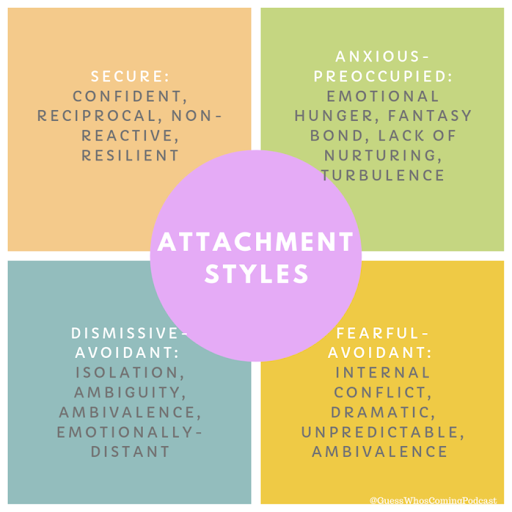
Romantic relationships are at the core of what many of us believe is the ultimate life goal – to have someone that loves us, respects us, who is with us for the long haul. We have the entertainment industry and global brands such as Disney and Hallmark to thank for that, as well as the social expectations that have been built out of the “happily ever after” they promote. Yet, so many adults and young adults find themselves in unhealthy relationships that are difficult to break away from. We believe in the power it takes to understand and recognize the signs of a toxic relationship. A key to identifying healthy relationships is not only recognizing the circumstances outside of you but the circumstances within you, such as your attachment style (aka the way you seek and define love through relationships).
Our blog today will discover the significance of your attachment style, and what you can do to strengthen your ability to form healthy connections. Keep reading!
What is Attachment Style?
Attachment theory, a lens founded by psychologist Dr. John Bowlby, is focused on the psychological bond that occurs between people. The theory developed in how psychologists understood the connectedness between parents and children, which later translated to how we form romantic connections. The philosophy of attachment theory is that our early emotional experiences with caregivers can extend throughout our lifespan. Therefore, when we are armed with the knowledge of how we connected in childhood, we might be able to decipher how this shows up in our relationships.
There are 4 major types of attachment styles:
1. Secure Attachment
In childhood, you regularly had your needs met. You felt safe to explore the world with a secure anchor in how you felt nurtured by your parents. Adults with secure attachment styles are often those who are comfortable with emotional expression, are more susceptible to trusting others, and respect boundaries. These individuals can recognize harm and have flexible emotional temperaments when it comes to rejection.
2. Anxious/preoccupied Attachment
In childhood, the care you received was inconsistent, unstable, or perhaps came with conditions. You felt nervous or scared about when you might get what you needed and perhaps operated under some feelings of scarcity. As an adult, you often feel insecure about your relationship and wonder whether the love you receive is true or lasting. Adults with anxious attachment might idolize the process of love yet fear that it will escape them through a partner’s abandonment or rejection of them.
3. Dismissive-avoidant Attachment
In childhood, the care you received was insufficient and perhaps bordered on neglect. You might have understood that other people couldn’t care for you, so you must rely on yourself. Adults with dismissive attachment styles may experience short, surface-level relationships marked by hyper-independence, emotional distance, and lack of shared problem-solving. You might be used to suffering in silence or isolation, so having a partner around to lean on may feel overwhelming or strange.
4. Fearful/avoidant Attachment
In childhood, you were outwardly abused, harmed, or cast off. You felt an urge to be loved by your caregivers but were scared of the unpredictability of those around you. As an adult, you probably feel the pull to be loved, yet work tirelessly to maintain your independence to avoid being hurt. Adults with fearful/avoidant attachment styles may feel like their emotions are “too much”, that they are inconsistent with what they want with partners, and anticipate pain.

Working from Within
Perhaps the most beautiful part of this theory is that it is not a life sentence. While you might move throughout your life operating under the beliefs, values, or behaviors of an attachment style, insight and awareness can help you to break free of the old cycles that keep you stuck in them.
Here are a few tips to make peace with yourself and your inner child to start to accept the love you deserve instead of accepting the love that feels familiar.
In anxious/preoccupied attachment styles…
- Take an inventory of what you are hungry for. What do you value in a relationship? Is this similar or different to your family system or the way in which you grew up?
- Utilize mindfulness to nurture your nervous system. When we operate on anxious thoughts or beliefs, our body will often tell us about it first. Grounding and mindfulness techniques can balance the chemicals in your body responsible for the urge you get to fight, escape, or become complacent to the person in front of you.
- Openly communicate what you are feeling with your partner. Consider how your fear of rejection might find its way even into daily conversations, and journal about how this makes you feel. Then prioritize telling your partner to open up opportunities to work on it together.

In dismissive-avoidant styles…
- Contemplate how your independence has served you thus far, and then challenge yourself to think of the ways you can keep your autonomy AND the ways you can share the load. What are things you don’t like doing that you are willing to hand over responsibility to your partner? What are the things you really cherish keeping to yourself, and what would it feel like to share them?
- Notice how often you find yourself in isolation, whether it be physical or emotional. Are there exceptions to this? When do you find yourself craving your partner’s presence, and how might you tell them?
- Journal about how the inconsistency you have felt in relationships shows up in how you care for yourself. Are there ways you can be more accountable for letting yourself be known?
In fearful-avoidant styles…
- Tap into your resilience and consider the ways in which you have cared for yourself when your reality was that it was just you. Write about how you knew how to survive despite a lack of role model. How might you explain this strength to your partner?
- Seek therapy to work on residual trauma, pain, or blaming you might find yourself going to when you feel activated by a relationship. There is room to relearn and unlearn the ways you have known love.
- Ensure that communication is done in times where you are calm, grounded, and able to hear both yourself and your partner. So much of your experience was likely blemished by the pain inflicted by caregivers or past partners, and being attuned to your environment is key to finding resolve.
Above all else, remember that you are deserving of a love that is full, consistent, enthusiastic, and on time.
To learn more about how individual and couples’ therapy can help in building secure relational attachments, visit us at https://www.new-perspective-counseling.com.
New Perspective Counseling is a group practice dedicated to emotional wellness and healing. Our caring therapists provide psychotherapy, individual counseling, marriage counseling and family counseling in our Highland, Michigan office. We are located conveniently near Milford, White Lake, Commerce Township, Holly, Hartland and Brighton, Michigan.
